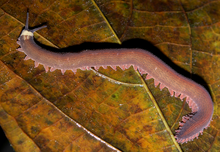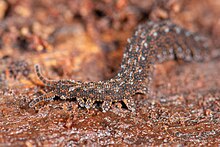
Back حاملات المخالب Arabic حاملات المخالب ARZ Onixoforlar Azerbaijani Аніхафоры Byelorussian Онихофори Bulgarian Onychophora BS Onicòfors Catalan Mananap nga kuyamas CEB Drápkovci Czech Stummelfüßer German
| Onychophora Temporal range: stem group from Cambrian
| |
|---|---|

| |
| Oroperipatus sp. (Peripatidae) | |

| |
| Ooperipatellus sp. (Peripatopsidae) | |
| Scientific classification | |
| Domain: | Eukaryota |
| Kingdom: | Animalia |
| Subkingdom: | Eumetazoa |
| Clade: | ParaHoxozoa |
| Clade: | Bilateria |
| Clade: | Nephrozoa |
| (unranked): | Protostomia |
| Superphylum: | Ecdysozoa |
| (unranked): | Panarthropoda |
| Phylum: | Onychophora Grube, 1850 |
| Subgroups | |
| |

| |
| Global range of Onychophora extant Peripatidae fossils
| |
Onychophora /ɒnɪˈkɒfərə/ (from Ancient Greek: ονυχής, onyches, "claws"; and φέρειν, pherein, "to carry"), commonly known as velvet worms (for their velvety texture and somewhat wormlike appearance) or more ambiguously as peripatus /pəˈrɪpətəs/ (after the first described genus, Peripatus), is a phylum of elongate, soft-bodied, many-legged animals.[1][2] In appearance they have variously been compared to worms with legs, caterpillars, and slugs.[3] They prey upon other invertebrates, which they catch by ejecting an adhesive slime. Approximately 200 species of velvet worms have been described, although the true number of species is likely greater. The two extant families of velvet worms are Peripatidae and Peripatopsidae. They show a peculiar distribution, with the peripatids being predominantly equatorial and tropical, while the peripatopsids are all found south of the equator. It is the only phylum within Animalia that is wholly endemic to terrestrial environments, at least among extant members.[4][5] Velvet worms are generally considered close relatives of the Arthropoda and Tardigrada, with which they form the proposed taxon Panarthropoda.[6] This makes them of palaeontological interest, as they can help reconstruct the ancestral arthropod. Only two fossil species are confidently assigned as onychophorans: Antennipatus from the Late Carboniferous, and Cretoperipatus from the Late Cretaceous, the latter belonging to Peripatidae.[5][7] In modern zoology, they are particularly renowned for their curious mating behaviours and the bearing of live young in some species.
- ^ Holm, E.; Dippenaar-Schoeman, A. (2010). The Arthropods of Southern Africa. ISBN 978-0-7993-4689-3.[page needed]
- ^ Prothero, D. R.; Buell, C. D. (2007). Evolution: What the Fossils Say and Why It Matters. New York: Columbia University Press. p. 193. ISBN 978-0-231-13962-5.
- ^ Ruppert, E. E.; Fox, R. S.; Barnes, R. D. (2004). Invertebrate Zoology: A Functional Evolutionary Approach (7th ed.). Belmont: Thomson-Brooks / Cole. p. 505. ISBN 978-0-03-025982-1.
Because they resemble worms with legs ... Superficially they resemble caterpillars, but have also been compared with slugs
- ^ Piper, Ross (2007). "Velvet Worms". Extraordinary Animals: An Encyclopedia of Curious and Unusual Animals. Greenwood Press. pp. 109–11. ISBN 978-0-313-33922-6.
- ^ a b Cite error: The named reference
GarwoodEdgecombe2016was invoked but never defined (see the help page). - ^ Fishelson, L. (1978). Zoology. Vol. 1 (3rd ed.). Israel: Hakibutz Hameuchad Publishing. p. 430.[verification needed]
- ^ Cite error: The named reference
G18was invoked but never defined (see the help page).